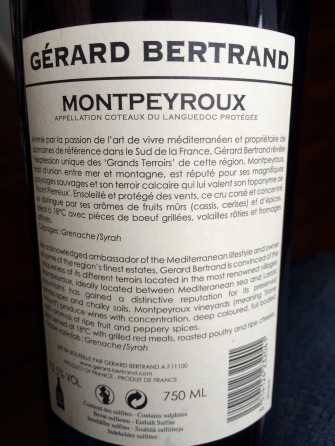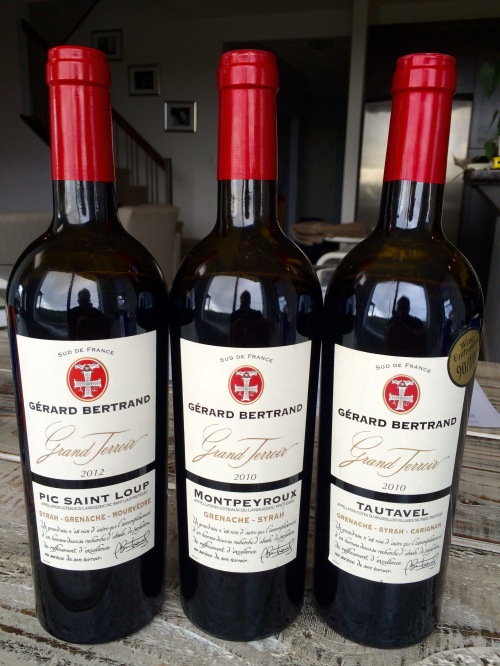[These bottles were provided as samples for review purposes.]
This is the kind of tasting opportunity that wine geeks drool over: three bottles, one producer, one general wine region, similar grapes, identical pricing ($25ish), same winemaking processes, but three different and distinct subregions, each with their own soils, microclimate and story to tell.
The producer is Gerard Bertrand, visionary winemaker from the south of France who was literally born to do what he’s doing: a local of the area, he started making wine with his father at the age of 10. The region is the Languedoc-Roussillon, a sun-drenched area stretching along the Mediterranean coast on the southern edge of central France. It is the world’s single biggest wine-producing area with around 700,000 acres under vine, although this is not necessarily a good thing; it has been known as the “wine lake” of France for churning out vast quantities of crude jug wine for cheap consumption, more than people could possibly buy, creating massive stockpiles of reputation-draining plonk and setting the region back in the eyes of the wine world. However, the Languedoc-Roussillon is in the midst of a quality renaissance thanks to a few passionate producers, Bertrand included, who see the potential for greatness in the land. The result, if you know what (or, more accurately, who) to look for, is a series of unparalleled wine values that can knock your socks off for the price.
 You don’t see many wines with Languedoc-Roussillon subregions on the label in this market: either they’re from the popular catch-all Vins de Pays d’Oc (now known as Pays d’Oc IGP) umbrella region or from a similar overarching area like Cotes du Roussillon. I have been heavily into wine for a number of years and had never heard of two of the three sub-zones highlighted in this trio of bottles: Tautavel and Montpeyroux. The third, Pic Saint Loup, is probably the best-known quality subregion in the Languedoc, but it remains woefully underrepresented here. Bertrand’s Grand Terroir series of wines is intended to change that and to shine the spotlight on these specific and distinctive parts of Languedoc-Roussillon, to prove that the area is more than just a bulk conglomerate. After tasting the three Grand Terroir bottles side by side by side, I have to say that he’s on to something. The terroir showdown begins now!
You don’t see many wines with Languedoc-Roussillon subregions on the label in this market: either they’re from the popular catch-all Vins de Pays d’Oc (now known as Pays d’Oc IGP) umbrella region or from a similar overarching area like Cotes du Roussillon. I have been heavily into wine for a number of years and had never heard of two of the three sub-zones highlighted in this trio of bottles: Tautavel and Montpeyroux. The third, Pic Saint Loup, is probably the best-known quality subregion in the Languedoc, but it remains woefully underrepresented here. Bertrand’s Grand Terroir series of wines is intended to change that and to shine the spotlight on these specific and distinctive parts of Languedoc-Roussillon, to prove that the area is more than just a bulk conglomerate. After tasting the three Grand Terroir bottles side by side by side, I have to say that he’s on to something. The terroir showdown begins now!
Wine #1: 2012 Gerard Bertrand Grand Terroir Pic Saint Loup
 The western Languedoc (which, for any board game fans, contains the fortress town of Carcassonne) sits on top of the Roussillon, with the eastern Languedoc following the coast the other way towards Provence. Pic Saint Loup is the middle of the eastern Languedoc, within the larger region of Coteaux du Languedoc and in the foothills of the Cevennes Mountains. Its combination of limestone soils and cliffside sun exposure has made it a renowned area for complex and concentrated wines, the only distinct Languedoc sub-terroir to really step out on its own internationally in a big way. This was the youngest of the three bottles I opened (the others are two years older, from 2010) and was a classic southern Rhone-style blend of Syrah, Grenache and Mourvedre.
The western Languedoc (which, for any board game fans, contains the fortress town of Carcassonne) sits on top of the Roussillon, with the eastern Languedoc following the coast the other way towards Provence. Pic Saint Loup is the middle of the eastern Languedoc, within the larger region of Coteaux du Languedoc and in the foothills of the Cevennes Mountains. Its combination of limestone soils and cliffside sun exposure has made it a renowned area for complex and concentrated wines, the only distinct Languedoc sub-terroir to really step out on its own internationally in a big way. This was the youngest of the three bottles I opened (the others are two years older, from 2010) and was a classic southern Rhone-style blend of Syrah, Grenache and Mourvedre.
The Pic Saint Loup was a bright translucent ruby colour and swirled with aromas of wild savoury herbs and underbrush, tomato, black raspberry and blackberry fruit and pen ink, with a lingering sanguine note adding an extra animalistic streak. Unfortunately, that wasn’t the only lingering note on the wine: there was also an ever-so-slight but unavoidable top note of mildew and mustiness, like the smell you get when you open the door of a long-uncleaned basement shower. This was a strong indication that the wine was sadly corked, affected by a compound called TCA (2,4,6-trichloroanisole) likely present on the cork or the winemaking equipment. (As an aside, my suggestion for trying to figure out if a wine is corked: do NOT swirl it before you smell it. The musty, wet newspaper-y TCA smell lingers overtop of the other aromas, and when you swirl the glass you agitate and amplify these other smells, which can make them mask the scent you’re trying to detect.)
The cork taint on the wine was not so severe as to render it undrinkable, and it actually put forth a pretty credible showing in spite of it: the palate still churned out dried blueberry, Herbes de Provence, parchment, anise and chalky/rocky notes on a bed of smooth rolling tannin. But the verve and the edge had been sapped from the bottle, leaving it a touch less than fresh and a bit tired on the finish. I would have scored this in the 86ish range if it was in condition, so I presume it has the capacity for much more when it isn’t fighting cork bacteria.
Not Rated (Corked)
$20 to $25 CDN
[UPDATE: After posting this piece, I got a chance to try a non-corked version of the Pic Saint Loup – you can read about it here. Overall tasting thoughts: serious quality and elegance. Final score: 90 points.]
Wine #2: 2010 Gerard Bertrand Grand Terroir Montpeyroux
 Wine #1’s DQ made the Bertrand terroir competition a two-bottle race, and the Montpeyroux came out gunning for the crown. Montpeyroux is also in the eastern Languedoc, just slightly southwest of Pic Saint Loup, in a high-altitude zone known for producing intense wines. Its name (Montpeyroux = Mont Pierreux = Rocky Mountain) reflects these characteristics (and also makes it a sister region to Calgary as far as I’m concerned). This bottle was Grenache-dominant, blended only with Syrah, a slight departure from its predecessor in the competition.
Wine #1’s DQ made the Bertrand terroir competition a two-bottle race, and the Montpeyroux came out gunning for the crown. Montpeyroux is also in the eastern Languedoc, just slightly southwest of Pic Saint Loup, in a high-altitude zone known for producing intense wines. Its name (Montpeyroux = Mont Pierreux = Rocky Mountain) reflects these characteristics (and also makes it a sister region to Calgary as far as I’m concerned). This bottle was Grenache-dominant, blended only with Syrah, a slight departure from its predecessor in the competition.
Based its Grenache-heavy composition, I poured the Montpeyroux expecting another see-through red-hued wine, only to be stopped in my tracks by the deeper, darker, almost wholly opaque liquid in the glass. I immediately wondered if I was getting something ominous and massive from this elevated subregion, but one whiff of the nose laid those fears to rest: it was just a pure beam of sweet cassis, exuberant and juicy black currant Wine Gums always and forever. I spent a couple minutes trying to tease out more aromas (and got dill and, seriously, crispy chicken skin for my trouble), but this is just a study in cassis on the nose and we shouldn’t try to complicate that.
Unsurprisingly, the essence-of-currant train just keeps on rolling on the palate, bursting with buoyant and excitable fruit with a touch of wild herbaceousness. However, the real story once you sip is the wine’s lush yet airy mouthfeel and almost floating, weightless structure. There’s so much purity and power to the Montpeyroux without the sense of weight or heaviness that usually goes along with it, and at 13.5% alcohol it finishes with the deftest touch of the three wines. Simply beautiful.
91 points
$20 to $25 CDN
Wine #3: 2010 Gerard Bertrand Grand Terroir Tautavel
 This is the Roussillon’s entry into the battle, making it the southernmost wine in the competition. Tautavel is a village located just inland from the Mediterranean coast, flanked by the Pyrenees on its other side and featuring pebbly soils and more sun-soaked south-facing hillsides. The wines do not want for ripeness, to which the 15% abv on this bottle is a testament. This was another Grenache/Syrah combo, but this time buttressed by Carignan, a completely under-appreciated grape that lends a little bit of everything (colour, structure, body, texture) to a blend.
This is the Roussillon’s entry into the battle, making it the southernmost wine in the competition. Tautavel is a village located just inland from the Mediterranean coast, flanked by the Pyrenees on its other side and featuring pebbly soils and more sun-soaked south-facing hillsides. The wines do not want for ripeness, to which the 15% abv on this bottle is a testament. This was another Grenache/Syrah combo, but this time buttressed by Carignan, a completely under-appreciated grape that lends a little bit of everything (colour, structure, body, texture) to a blend.
The main noticeable thing about the colour of the Tautavel was a clear rust/garnet tinge to it not present in the other two bottles. It smelled more charred and meaty than the Pic Saint Loup or the Montpeyroux, a mix of grenadine fruit, spice, smoke, sweat and sandpaper that seemed the most classically “wine-like” of the three, if that makes sense. Despite being a full degree and a half higher in alcohol, it stayed well within itself, never coming across hot or overextracted, just delivering robust, slightly rustic flavours in a non-overbearing way.
As potentially predicted by the inclusion of Carignan, there was in fact more of everything in the Tautavel in terms of structure: a broader body, bolder, sandier tannin, striking acid. The fruit flavours veered more towards red than black and towards dried rather than fresh (Craisins, anyone?) and were accentuated by sunbaked earth, dust, chocolate and black pepper. This bottle is simply solid through and through, the ideal foot soldier for your journey through the peaks and valleys of wine, unyieldingly reliable even if not completely revelatory.
89 points
$20 to $25 CDN
So the Montpeyroux sort of walks to the crown of the Bertrand terroir challenge, albeit in a mildly controversial fashion thanks to the cork-fuelled downfall of the Pic Saint Loup. However, corked wine notwithstanding, my main takeaway from this tasting experience is that it might be time to start respecting the idiosyncrasies and unique characteristics of the various areas that make up the Languedoc-Roussillon, particularly if more producers in the area start doing the same. There will always be an audience for character and quality.








Here’s where our place is located – at the tip of the arrow. We’re going to try and get to Gerard Bertrand this weekend for a tasting.
Jim Maddocks
>
LikeLike
Hey Jim, the arrow came through but the map/pic didn’t…hope you’re able to make it out to the winery!
LikeLike